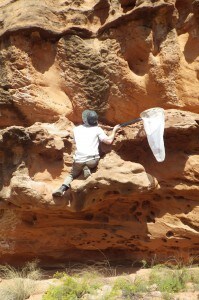Share this article
New bee species carves nests out of sandstone
In the Southwest desert, bees carve tunnels in sandstone. Their mandibles scratch the rough surface, while water carried in their bodies softens the cement between grains. The labor eventually wears their mouthparts down to nubs.
“They’re basically chewing the sandstone apart,” said Michael Orr, an entomologist at Utah State University. “The big question for me was why they would be doing this, because the costs of excavating sandstone are obvious.”

Michael Orr collects bee specimens on a sandstone cliff in southern Utah. ©David Denlinger
The bees are Anthophora pueblo, a new species that Orr and his colleagues described in a recent study in Current Biology. Like other solitary bees, A. pueblo females excavate tunnel-shaped nests and divide them into a series of chambers, each one containing an egg and a supply of nectar and pollen. Orr’s co-author Frank Parker first found the species in 1980 nesting in a wall of sandstone in Utah, and chiseled out a hunk of the rock so he could watch the young bees emerge in the lab. But Parker’s work remained unpublished until now, when Orr became interested in the holes dotting certain sandstone cliffs.
A. pueblo isn’t the only species of bee to use sandstone. Seven bee species have been documented nesting in the tough material, although it isn’t clear that all of them excavate their own tunnels, says Orr. But while entomologists have noted the behavior in the past, this study is among the first to examine it in detail.
Unsurprisingly, sandstone nests appear to be challenging for the centimeter-long insects to construct. Orr observed large amounts of wear on females’ wings and mandibles, presumably from scratching against the abrasive surface, though he hasn’t confirmed this through controlled experiments. Moreover, he found that the rock the bees choose is about 2.5 times softer than the average sandstone in nearby areas. The researchers found a total of seven nest aggregations, all of them near sandstone and five of them in the rock itself. At the two locations where the bees nested in silt, the surrounding rock was much harder.
“It seems like they’ll very readily use sandstone up to a specific hardness threshold, and then they’ll actually start using other things,” he said. “So it really does seem like they prefer the sandstone wherever possible.”
The bees need water as well as soft sandstone, further limiting where they can nest in their desert habitats. At the rare locations with suitable nest sites, hundreds of bees nest in close proximity, riddling the cliffs with holes. Such a high density of bees could increase the spread of diseases and parasites, says Orr.
So why would a bee limit itself to a few overcrowded nest sites, only to spend its life painstakingly digging into rock? The researchers explored several possibilities. First of all, says Orr, the nests are built to last. When he returned to the site where Parker discovered the species in 1980, he found that it still supported a thriving population, making it the longest-lasting aggregation of wild, unmanaged bees ever documented.
“They’re actually able to use the exact same place for almost 40 years — something which is almost unheard-of in bees,” he said.
The sandstone likely offers protection from predators and weather, including the flash floods that frequently surge through desert canyons. A. pueblo typically nest high on sandstone walls, above the worst of the flooding. And unlike dirt and silt, sandstone can survive a flood without washing away. This security apparently makes it possible for immature bees to delay their emergence, waiting in the nest until they sense the right conditions for foraging and breeding. Some of the bees Parker brought back in his block of sandstone didn’t emerge for four years.
And while the density of bee nests could increase the risk of disease, the sandstone itself may help the bees stay healthy. Compared with substrates such as silt, sandstone supports few microorganisms, and the microbes that do live there are mostly autotrophs that won’t cause problems for bees, says Orr.
Many parasites try to take advantage of the bees and their nests, but it may be that few actually succeed. The most common parasite in Parker’s rock sample was a beetle called Tricrania stanisburii. Larvae of this species hitch rides on adult bees, crawling off when they reach the nest so they can feed on the bees’ nectar and pollen. Sixty-three of the nest cells in Parker’s sample contained T. stanisburii beetles, more than the number containing actual bees. But only six beetles emerged alive, the rest perishing inside their sandstone nurseries.
“The larvae will grab onto bees at flowers and ride back into the nest, so they never have to break in,” said Orr. “Instead, they have to break out. And by and large, they actually can’t.”
While this doesn’t save the bees in beetle-infested chambers, it could prevent beetle populations from building up over years, says Orr.
More research is needed to determine the most important benefits of nesting in sandstone, says Orr. Scientists will need to use models and experiments to test each possible benefit, quantifying and comparing their contributions to reproductive success. Orr is also eager to find out how the bees are faring in the face of threats such as climate change and human water use.
“There are still so many questions to be asked,” said Orr. “I think this bee is a testament to how much there is out there yet to be explored in the natural world.”
Header Image: An Anthrophora pueblo bee peeks out from its nest in southern Utah. Researchers recently described the species for the first time, along with its sandstone-excavating habits. ©Michael Orr








